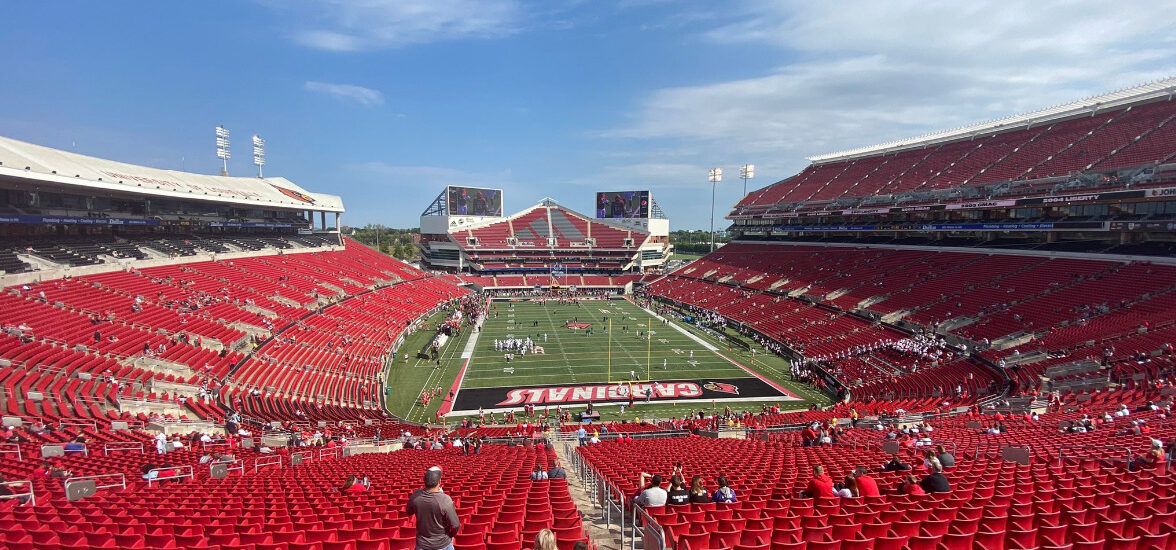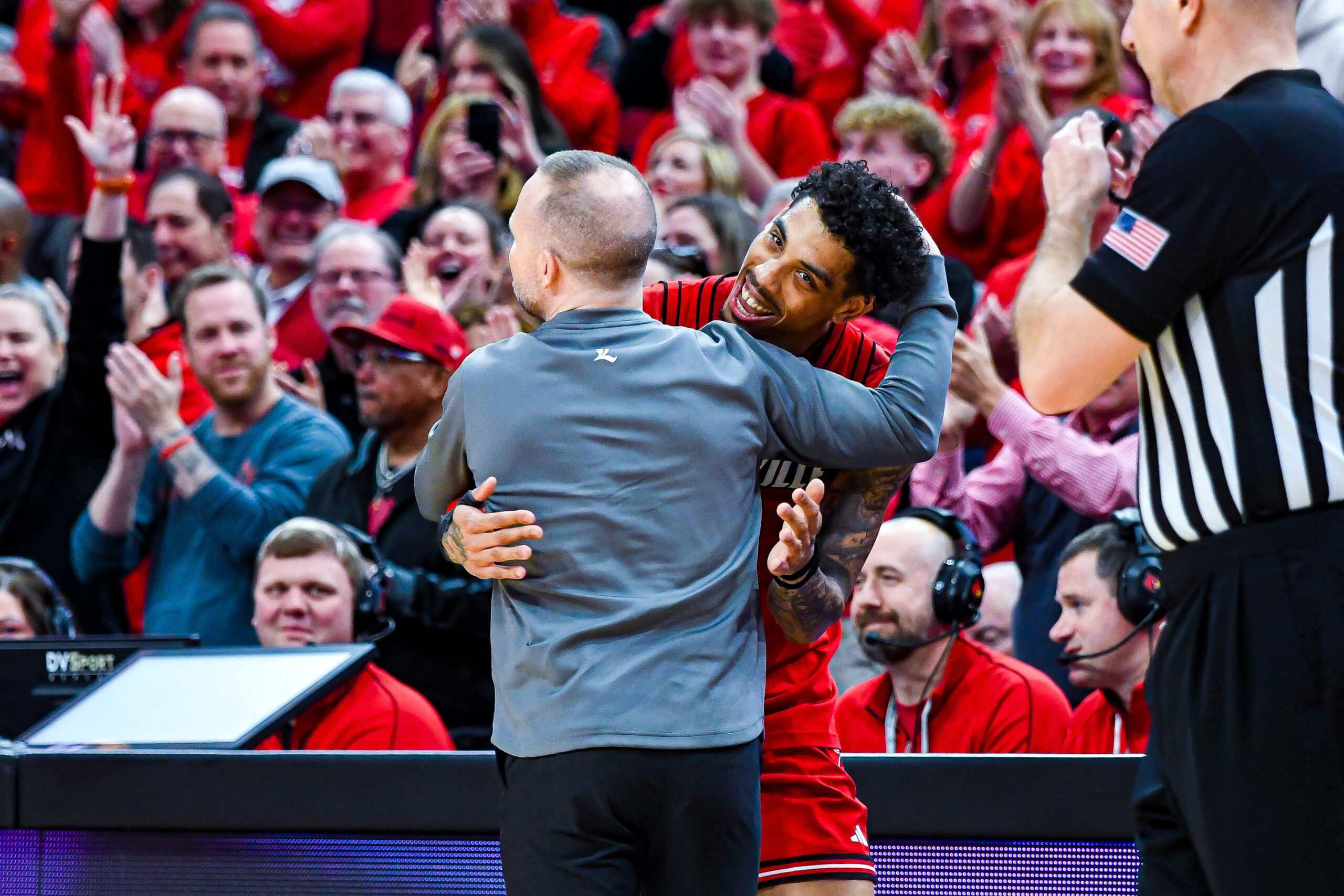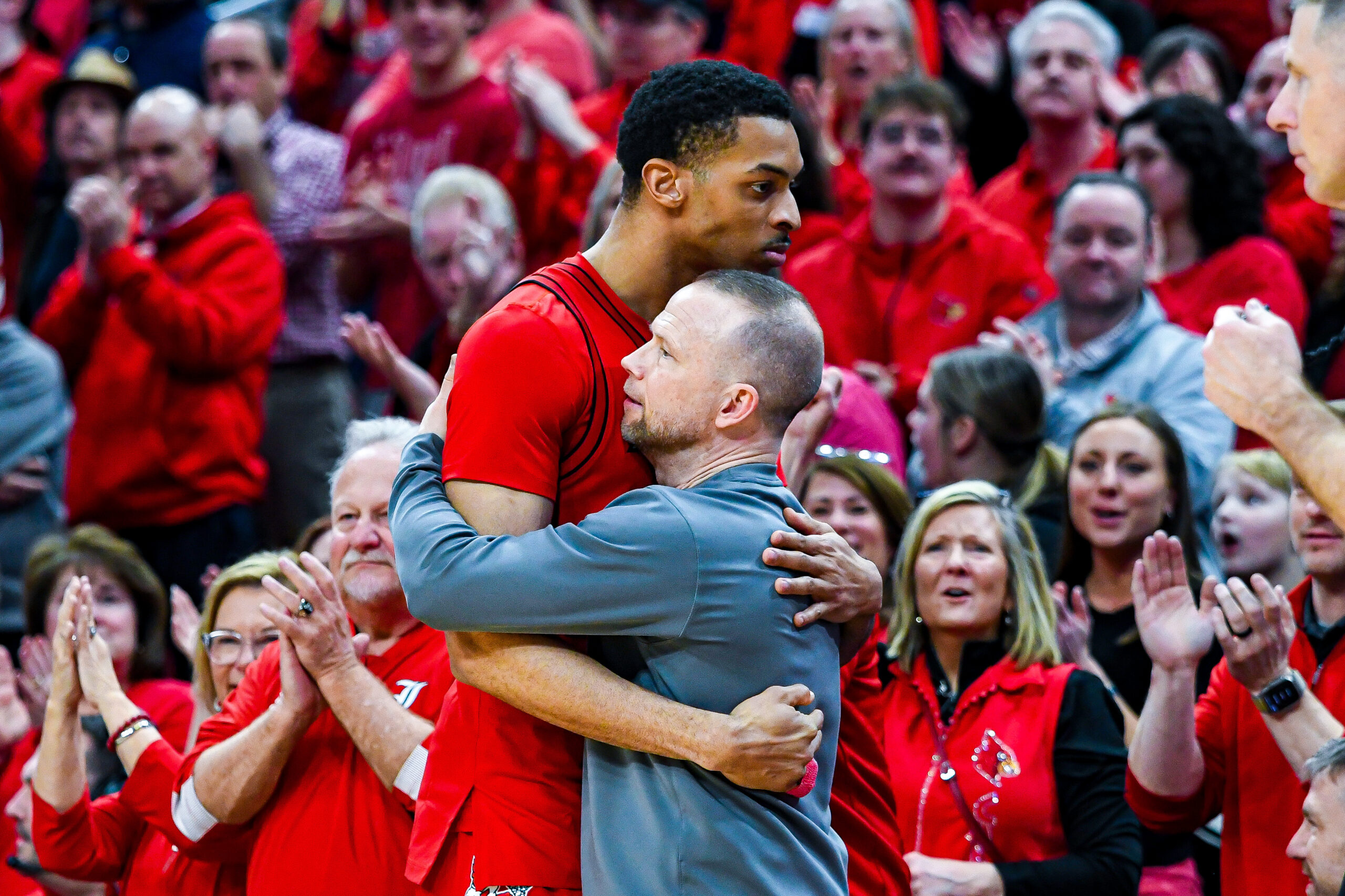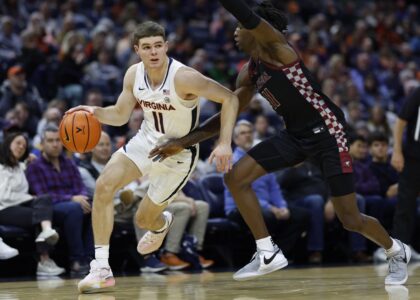As University of Louisville athletics tries to right the ship during turbulent times in football and basketball, a lack of funding may jeopardize its ability to replace its football coach.
- Nearing the halfway point of the 2022 season, Louisville faces the decision of whether or not to retain head coach Scott Satterfield
- Louisville Athletics faces an uphill financial battle after multiple buyouts totaling nearly $40 million
- Hiring a coach like Jeff Brohm may not be a luxury that Louisville can afford
Louisville football is preparing to enter the back half of a season where its fans and supporters will be more concerned with its next coach than the current product on the field.
And, while Athletic Director Josh Heird is in the unenviable position of dealing with the constant PR headache of another losing football season, the coaching market looks promising.
The University of Louisville, its facilities, fans, ACC TV contract, future schedule, and more sell themselves. If Louisville makes the decision to cut ties with current head coach Scott Satterfield, there are likely to be plenty of viable suitors for the position.
However, the elephant in the room that most supporters of the program are uncomfortable talking about is the financial aspect of firing a coach under contract and bringing in a completely new coaching staff.
For a power five program like Louisville to make a major coaching change, it is not as simple as going back to an imaginary unlimited reservoir of money. My educated guess is that the athletic program may have much more seriously considered a different future for its current football coaching staff had it held the money to do so after the 2021 season.
Throw in the fact that the university was saddled with yet another buyout of former Men’s Basketball head coach Chris Mack and entered a new contract with current Head Coach Kenny Payne, and you have a recipe for another headache along the financial ledger for years to come.
I totally understand, as a lifelong fan, the desperation among the fanbase to win and win now. The 2013 season where Louisville football won a BCS Bowl Game, Louisville basketball won a national title, Louisville women’s basketball played in the national title game, and Louisville baseball made it to the College World Series feels like much more than a decade ago. The scandals, heartbreak, and downfall of a once proud athletic program that ensued were an incredibly difficult burden to carry for fans who live and die by the results of their favorite teams.
However, it’s also important to understand the financial implications of this downfall to gain a better understanding of where Louisville stands, what its options are, and what to realistically expect during the Satterfield era and beyond.
Through Open Records Requests and candid conversations with Louisville boosters, I sought to gain a better understanding of the decisions that go on behind the scenes.
Assessing Louisville athletics net worth
In regards to how much value the university carries, the University of Louisville has not, and will not soon, approach anything close to a solvency issue. More simply put, UofL has the ability to leverage its debts against its assets.
In terms of how much the university is worth, despite a difficult year in 2020, UofL held serve across the entire university- Not just in the athletic department.
UofL’s net worth is calculated by adding all of the university’s assets and subtracting the liabilities. According to the University of Louisville annual auditor’s report, “Current Assets consist primarily of cash; loans, accounts and contributions receivable, inventories, due from affiliates and investments held with the Foundation.”
Louisville athletics fans often think of sports as a major component. In actuality, Louisville athletics is a much smaller piece of a very large, very lucrative pie. According to Louisville’s annual report, the operating expenses of the athletic department accounted for less than 10% of the overall money spent last fiscal year.
In terms of net worth (again, Net worth = Assets – liabilities), Louisville athletics are performing as expected. In the last normal (non-COVID) fiscal year, Louisville increased its assets while decreasing its liabilities.
Louisville’s net worth will typically peak at the beginning of each fiscal year. As of the final fiscal quarter in 2021, Louisville athletics’ net worth or net position was approximately $145 million.
Surviving the COVID-19 pandemic
Former Louisville Athletic Director Vince Tyra earned a mixed, often ambivalent, reputation for a number of things.
However, if there is one thing that we should look back on in a decade and applaud Tyra for, it will be his handling of the COVID-19 pandemic.
Tyra made the difficult decision to cut budgets, furlough employees, and tighten up some loose ends in 2020. The result was a pretty clean balance sheet at the conclusion of the 2020 fiscal year.
This is a simple business principle that Tyra assuredly has become accustomed to throughout his career, and a reason why he made sense as a permanent hire when former AD Tom Jurich was ousted in 2018. When the money stops coming in, you have to find a way to not spend money you do not have.
Louisville only lost an estimated $3 million in cash flow during a sports season massively impacted by a worldwide pandemic.
If the University of Louisville remembers nothing else from Tyra’s tenure going forward, the program’s ability to tighten its belt and make difficult decisions during this time may ultimately be what steadied a ship headed far off course.
Where the issues lie: Understanding cash flow vs. restricted cash
In regards to assets, we have established that Louisville athletics and the University of Louisville are doing a tremendous job year-over-year.
However, where the issues lie for UofL athletics going forward deals with the overall cash flow that keeps the athletic department afloat- And in the past, kept it flourishing.
Cash flow can be defined as unrestricted cash. Cash flow includes donations, ticket profits, concessions, and various other avenues through which the university brings in money.
Unrestricted cash is how UofL operates on a day-to-day basis. From paying coaching salaries to small nuanced operational things that fans don’t even think about, unrestricted cash flow is how UofL pays for the majority of its expenditures.
As a non-profit organization, donations are the lifeblood of the University of Louisville athletics department, and any athletic department across the country.
Restricted cash, on the other hand, is money that is donated, gifted, or otherwise given for a specified purpose.
For example, the $3 million that Rick and David Keuber donated to help the university remodel its practice facility in exchange for naming rights of the Keuber Center- Is restricted cash. Money pledged by Angels Envy to renovate what was formerly the Brown and Williamson level of Cardinal Stadium is restricted cash. Anything that is held and not available for immediate use would fall under this umbrella.
This is an important distinction to keep in mind when discussing the financial viability of the Louisville athletics programs going forward.
The loan
The next thing that is important to consider when examining the current financial state of the athletic department is how Louisville is spending money that it did not bring in.
In April of 2021, the athletic department took out a $20 million line of credit from Louisville-based Republic Bank.
“Covid-19 has negatively impacted Athletic Department revenues by more than $45M in the past 12 months,” the ULAA stated in the written proposal. “Approximately $25M of this revenue shortfall has been mitigated through department-wide expense reductions. Despite these aggressive measures, operating expenditures will exceed revenues in fiscal year 2021.”
Shortly after receiving the loan, UofL spent $9 million of the Republic Bank credit line in April.
Keep in mind, this is a capital loan. The university is responsible for paying back the money or risks losing ownership over its leveraged assets.
Where Louisville stands financially
When Louisville spent $9 million in borrowed money in April, the athletic department dropped approximately $13 million in internally generated cash.
So, although the balance will show that Louisville has its head just above water, it’s important to consider the line of credit and that Louisville will still be in the hole for any money that goes against this credit line.
Figure A and B show the decrease in cash flow year over year since 2017 and illustrate the spending issue Louisville has had in recent years.
ULAA Cash Decrease Post-Jurich


UofL has an excess cash surge at the start of each fiscal year in June — This number goes down as it is depleted each year.
At the start of each fiscal year since Jurich left, Louisville’s cash flow has continued to decrease. Which is likely a major reason for the $20 million loan.
Simply put, Louisville athletics has been spending way more money than it is bringing in, and there has been no indication yet that the new administration has bucked this trend.
As of the end of the 3rd fiscal quarter on April 1st, 2022, Louisville’s liquid assets had decreased at least $78 million since Jurich’s departure.
Figures A and B show the result of an uncontrolled spending issue with a lack of unallocated funds coming in.
The bottom line number, when factoring in $9 million against Louisville’s line of credit is now, more than likely, negative. That is, unless something drastic has been done under Heird’s watch to stop the bleeding.
When you take into account that the loan is money Louisville owes, rather than money that it has to spend, there is a huge red flag in regards to digging itself out of this major financial hole.
As numbers become available, we can begin to paint a better picture of how Louisville is working to rectify the situation.
However, an educated assumption would be that the Louisville athletic department is working hard to bring in more unallocated funds from donors.
As of the end of the first quarter on March 31st, 2022, ULAA Foundation investments had dipped from $25 million in 2017 to $3.5 million. This is a number that Louisville athletics must see increase in order to right the ship financially.
What Louisville is spending money on
So, how exactly does Louisville find itself in this situation? A decrease in donations and profits since Jurich’s departure and an increase in money owed by way of coaching buyouts certainly has not helped.
While the Jurich administration did well to maintain cash flow coming in, Jurich undoubtedly left the program in a poor position when he left.
Much of what Louisville has been responsible for over the last five years has been paying the contracts of fired coaches.
Here are the coaching buyouts Louisville has been on the hook for prior to parting ways with Chris Mack.

Collectively, Louisville paid out — or will pay out– north of $35 million for letting go of previous coaches without cause.
Now, Louisville will have to pay Mack $1.6 million per year through 2024 for a total of $4.8 million.
All told, the Louisville athletic department will be responsible for settling debts of at least $39,963,250 since January of 2018.
How Louisville has counteracted budgetary issues
Cutting head coaching costs
One simple, and seemingly logical, solution that Louisville found during Tyra’s tenure was to simply save money by not overextending on coaching contracts.
How do you save money right away? By filling positions with people who are paid less money.
While Louisville athletics is still, quite literally, paying the price for signing Petrino to a contract with mind-boggling buyout numbers, Louisville signed Satterfield to a much more reasonable deal. Through 2026, Louisville will only pay Satterfield $3.25 million annually- Considerably less than a contract that would have paid Petrino $4.025 million in 2022.
Similarly, Louisville only shelled out $4 million a year to Mack, where it was paying Pitino $5.5 million, plus performance incentives. Kenny Payne is making $3.35 million per year- Another substantial drop in spending.
In 2021 alone, Louisville athletics paid its main revenue-generating head coaches and athletic director $4,235,000 less than it was contracted to with Jurich, Petrino, and Pitino at the helm. This number increased to nearly $5 million in 2022.
Basketball-specific budget cuts
If you’ve noticed some minor changes throughout the men’s basketball program in the post-Jurich era, it may be partially due to budget cuts made in 2018.
Per the University of Louisville Athletic Association, Inc Monthly Financial Analysis as of September of 2021, the proposed yearly budget for the men’s basketball program sharply decreased from fiscal year 2018 to 2019.
While the majority of sports at UofL have leveled out or seen slightly increased budgets since 2018, Louisville basketball slashed its budget from $9,529,327 in 2018 to $7,228,948 in 2019- more than a 24% decrease. Again in 2020, Louisville cut basketball spending to $6,775,661- a 6% decrease.
Since Tyra’s arrival, Louisville basketball slashed $10,646,015 from its operating budget. Most of the budget cuts- approximately $5.5 million- have come in the form of operating expenses.

Cash Flow in the Jurich era vs. Cash Flow in the Tyra Tenure
One of the primary concerns for Louisville athletics for the foreseeable future is the amount of cash flow available.
Unrestricted cash declined 22% from $72 to $56 million in the final six years of the Jurich era- a decline of 4% annually.
Contrast that to the most recent four-plus years when it has declined by 94%– an annual rate of 22%.
Excess cash on the balance sheet can also be a problem as far as a productive asset.
It’s possible that Jurich recognized that and made a deliberate effort to reduce it, in contrast to the current situation.
Whatever the case, the responsibility is now bestowed upon Heird and his staff to increase unrestricted cash flowing in while continuing to limit money spent.
What is to come under Josh Heird?
The good news for Louisville athletics is that this is not an unsalvageable situation.
I felt comfortable with the hiring of Josh Heird because of his experience working under Jurich and Villanova’s Mark Jackson. Heird’s background in college athletics will hopefully usher in a new era of fundraising and trust from boosters.
Major donors like Louisville staple Mark Lynn have grown estranged from the university in recent years and there has been a less than silent public distrust in the athletic department since Jurich’s parting of ways.
Heird serves as a solid intermediary between those who developed long-standing relationships with Jurich and a new era of donors who came on board during Tyra’s tenure.
While Jurich ruled with an iron fist and took calculated risks, Tyra made budget cuts and tried to right a ship in stormy seas. During that transition, however, there was a clear drop-off in donor funding and maintaining relationships from the previous regime.
A happy medium between the two previous ADs, Heird has the opportunity to regain the trust of old donors while bringing a no-nonsense approach to the position from a public perspective.
He has gotten off to a fantastic start by hiring Payne and constructing a NIL department at UofL in an interim capacity.
Now, Heird faces his toughest challenge yet- Making the decision to retain or part ways with Satterfield.
Addressing Satterfield’s contract
When he was hired, Scott Satterfield signed a 6-year contract that runs through the end of 2024.
If he’s fired without cause, Satterfield is to be paid 75% of the remaining value of his contract. So, if Satterfield is let go in 2022, Louisville will be on the hook for $4.875 million, or 75% of two years of his annual $3.25 million salary.
So, that begs the first question: Is it worth it to Louisville to wait things out?
Louisville paid Petrino north of $14 million to walk. They are paying Mack almost $5 million after he threw in the towel mid-season.
While the precedence has been set to do so, these are also recent firings that the university is on the hook for. It’s easy to say “it’s been done before, just do it again”, but given its current financial situation, that is easier said than done.
Obviously, there is also a precedence set where boosters and corporate donors can help alleviate the sting of forking over a buyout. However, on the heels of some pretty substantial payouts over the last 5-6 years, that is much easier said than done.
The most recent prominent example of this happening was just last month when Nebraska got rid of head coach Scott Frost just three games into the season. Nebraska boosters forked over a significant amount of money to help fund Frost’s $15 million buyout four years before his contract was up.
Do Louisville boosters have or want to pay that kind of money? And is the situation bad enough to warrant these actions? That remains to be seen, but the answer to those questions has almost always been a resounding “no”.
Finally, there is a clause in Satterfield’s contract where Louisville will not have to pay him the full amount of his buyout if he obtains employment elsewhere. I.e. if Louisville gets rid of Satterfield and can string his payments out into installments of, say, $812,000 over 6 years or $609,375 over 8 years, UofL might get out of some payments if Satterfield finds another prominent coaching gig.
The cost of hiring a new coach
Once the decision is made to part ways with Satterfield, there are obviously costs associated with hiring the new coach.
Louisville may pay upwards of $100,000 to a search firm to help secure their new guy. Glen Sugiyama is a familiar name that helped Louisville basketball come to the decision to hire Kenny Payne earlier in 2022.
For those on the Jeff Brohm train, Sugiyama has a track record with Brohm, having assisted Western Kentucky and Purdue during their searches in 2014 and 2017.
Then, there is the cost associated with signing the new coach to an enticing contract.
Back in 2018, Louisville and Brohm could not come to an agreement, and there were not so quiet whispers that contract negotiations were a major issue.
That discussion could rear its head again if Louisville decides Brohm is its guy.
In 2019, Brohm signed a 7-year, $36.8 million contract. That averages out to $5,257,142 a year after bonuses and other incentives. When he received his extension, Brohm was the 8th-highest paid coach in college football.
To put things into perspective, Petrino was paid $4.475 million in 2018 prior to his termination.
If Brohm were to make the move to his hometown team, one would think a pay cut isn’t in the cards. Can Louisville afford to pay someone like that? Are boosters willing to shell over money to see a change? That has never been the case in the past. It’s difficult to imagine that happening this time around.
Now, there have been fans clammoring for other coaches with Louisville ties that could be good fits as UofL’s next head coach.
Dave Ragone, former Louisville QB, and current Atlanta Falcons offensive coordinator makes $400,000 a year.
Former beloved Louisville defensive line coach Clint Hurtt, now the defensive coordinator of the Seattle Seahawks, does not have a contract available to the public. However, surmise it to say that he likely makes more than Ragone but less than $1 million annually.
Louisville fans really liked the hiring of Kenny Payne because of local connections. There are obvious opportunities out there to do so in football, but Brohm feels like the most untouchable financially.
And just for S&Gs since it’s being thrown around on social media, a coach known mostly for his stint with the Louisville Bats, Deion Sanders, makes $1.2 million annually and donates half of his salary back to Jackson State.
More realistically, I think Louisville football should be considering what has worked in the past: Offensive and defensive coordinators for high-level programs.
Georgia defensive coordinator Glenn Schumann makes $800,000.
Bill O’Brien, Alabama’s offensive coordinator, makes $1.1 million annually.
Ohio State defensive coordinator Jim Knowles makes $1.9 million in 2022.
And Oklahoma defensive coordinator Alex Grinch is set to make $1.8 million this season.
Louisville built much of its success over the last two decades on the backs of Auburn offensive coordinator Bobby Petrino and Florida defensive coordinator Charlie Strong.
The Cardinals faltered under head coaches in Satterfield (App State) and Steve Kragthorpe (Tulsa) and sputtered out after re-hiring Petrino post-Atlanta, Arkansas, and WKU.
This, of course, is not to say that it’s black and white. Louisville has examples of success under Howard Schnellenberger, John L. Smith, Lee Corso, and others. However, it’s important to realize that hiring another head coach making a lateral move is almost always going to coincide with pricier and lengthier guaranteed contracts with hefty buyouts- Something Louisville can ill-afford at this juncture.
Since Jurich’s departure, Louisville has consistently paid new coaches less than their predecessors in their initial contracts.
Based on the state of Louisville’s finances, I feel confident in predicting that this trend will continue with UofL’s next football coaching hire.
If things go well for the next coach, things should be going well for the university financially. With this being the case, I’d bank on a high-level coordinator being the next coach to get the job with bigger names out of reach for the near future.
Note: A previous version of this article listed Dan Lanning as Georgia’s defensive coordinator, but has been corrected.
You may also like:
- Let This Bull Run: Louisville Basketball’s Aly Khalifa Caught in NCAA Nonsense
- Four Things to do in Louisville Part 2
- Racing Louisville first quarter review: Is there room for hope?
- The Kentucky Derby: Decadent, Depraved, Still Going Strong
- Louisville can host the TBT Championship Game; But it’s up to the fans






Satterfield did not follow football protocol for head injuries for
Cunningham. He should lose his job over that. We all know that was a head injury on Sat. But Satterfield put Malick back very quickly. What top name quarterback would ever play for a coach like that.
Great thinking points! Didn’t realize our athletic program was strained as much as the article indicates.
However the product is suffering with this current football coach. He lacks enthusiasm, determination and fight. I am a former player under Howard Schnellenberger and even when we lost, we had fight. Players are a reflection of their coach. Satterfield doesn’t have fight, thus the players don’t have it.
Something has to be done.
I agre Jeff. Louisville deserves better than the coaching staff that’s currently in place. I don’t like to criticize people but Satterfield is an example of someone who rises to the level that is above his ability to manage.
Find a Saban assistant ready to move up and hire him. It’s worked pretty well for Georgia and Ole Miss.
Jeff Brohm????
Satterfield
1st year 8 – 5
2nd year 4 – 7
3rd year 6 – 7
4th year ? (Not looking good so far)
Brohm
1st year 7 – 6
2nd year 6 – 7
3rd year 4 – 8
4th year 2 – 4
If we are going to replace Satterfield, why would we replace him with Brohm?
Brohm just barely beat FAU at home by 2 points a couple of weeks ago, and probably would have lost had FAU not fumbled while driving for a game winning field goal. (Smh)
Jackson State in Jackson, Mississippi is where Deon Sanders is Head Coach. Not Jacksonville Stare in Alabamma
Fans want Coach O!!! With his LSU $$$$$$$ maybe a sliding scale contract is in the CARDS.
Really well done article. This is the most logical explanation I have seen of the current state of affairs, and future prospects.
Well,we’ll get what we pay for… A good coach, will cost…. So, dig deeper
Look at the Washington State University head coach Jake Dickert. His teams are fun to watch, and they are winning. I’m sure it’s difficult to recruit to eastern Washington state.
We need to give Dave Ragone
a hard look.He was a leader here and id doing an outstanding job wit the Falcons, just ask Sean Mc
about him. His current
salary is 400 K.
You might want to learn how to spell Kueber. They’re pretty important in terms of UofL Funding. Someday, you might understand the basics of successful athletics, unless you’re more of a moron than your writing suggests.
Good coaches recruit good athletes, Good athletes bring success. Success brings fans. Fans bring money.
Spuds